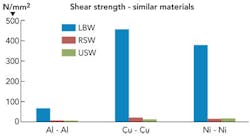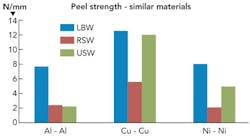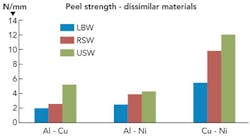Laser welding batteries for electric vehicles
David Speth and Jay Eastman
The automotive industry is beginning a major technology transition. The Toyota Prius, Honda Insight, Chevrolet Volt, and Nissan Leaf are the first electrified vehicles currently being sold. Over the next three years, all of the major automotive manufacturers and several startup companies will be introducing some form of hybrid, plug-in hybrid, or electric vehicle for the consumer and commercial market. While the internal combustion engine will continue to dominate the market for many years, electric drive systems will gain market share as the cost of hydrocarbon fuels increases.
The electric drive system in these vehicles requires new lithium ion battery technology. While lithium batteries have been used for cell phone and laptop computer applications for several years, the batteries' application to transportation will require systems with up to 1000 times more power. These drive systems will also need to function under demanding service conditions for at least 10 years. To be economically competitive with an internal combustion engine, the battery system will also need to cost less than half of what it does today. Meeting these demanding goals will require new, reliable, and inexpensive manufacturing approaches.
Industry status for joining
EWI has been working with advanced battery companies on this challenge for several years. As a part of the Symposium on Battery Manufacturing Technology held in September 2010, EWI surveyed the industry about the techniques (see TABLE above) being used to make joints during battery cell and pack assembly. The results of this survey showed that lithium batteries are complex assemblies of multiple layers of several materials (copper, aluminum, nickel, and nickel-plated copper) in a wide range of thicknesses (0.001-0.0625 in.).The manufacturing of the systems requires assembly of a large number of connections, including joints between dissimilar materials. To make these connections, the industry uses a wide range of processes, including soldering, resistance, ultrasonic, and laser welding. The survey results in the TABLE show that no single joining process dominates this application. No one seems to agree on which process to use for each material-geometry combination.
As a result of this survey, EWI and the Ohio State University Center for Automotive Research designed a project to investigate resistance, ultrasonic, and laser welding approaches to making joints between the material combinations involved in assembling lithium ion battery cells and packs. The goal was to develop data to help the industry match a joining process with each joint in the assembly.
Laser advantages
Laser welding is attractive because it is a very flexible and precise process. Welds can be sized and shaped to fit into small spaces and to adjust to a wide range of designs. Since laser welding is a non-contact process, an effective welding beam can be delivered into small spaces that are not readily accessible to ultrasonic or resistance welding heads. The welding process is high speed and does not involve a high heat input even though it is a fusion process.
Experiments
A 600-W IPG YLR-600-SM continuous wave ytterbium fiber laser that delivers a wavelength of 1070 nm was used for this investigation. The beam was delivered to the work piece with a 100 mm focal length lens that theoretically delivers a 9-μm spot. Even though both aluminum and copper are highly reflective (>90%) for infrared wavelengths around 1000 nm, welds could be made using only 55-75% full power (330-450 W).
A two-dimensional motion control system with a scan rate of 200-400 mm/s was used to make the welds. The laser study involved a full factorial designed experiment that incorporated all possible material combinations (aluminum 1100 or 1145, copper 110, nickel 200, electroless plated nickel on copper, electroplated nickel on copper); the presence or absence of argon shielding gas; and sample orientation (which material the laser beam addresses first). The bulk of the study was done with 125-μm-thick materials. All welds were full penetration through both substrates. Cross sections of two tab welds are shown in FIGURE 1.
For simplicity the laser welds were simple single scans across a 25-mm-wide test specimen. Both the mechanical and electrical performance of the welds were evaluated. Mechanical performance was evaluated using both lap shear and t-peel tests. The resistance of the weld was evaluated with a 1 second high current pulse delivered by a resistance welding power supply. Pulses ranged from 400-1000 A.
Results
Laser welding produces strong welds for all material combinations. It was particularly effective for making copper-to-copper and aluminum-to-aluminum welds. It was also the only technique that could weld combinations involving electroplated nickel on copper. In these experiments, the presence or absence of a shielding gas did not make any difference in either the mechanical or electrical performance of the weld. The only difference noted was welds made without shielding gas showed more surface oxidation than those made with shielding gas.Evaluation of the electrical performance of the welds was very interesting. Joints made with all three processes showed nearly identical resistance to current flow. Analysis of the results showed that even though the area of the laser welds was much smaller than that of the resistance or ultrasonic welds, the electrical resistance of a joint was independent of the welding process used. Instead, the resistance depended on the materials in the joint instead of the welding process used to join them.
Remaining challenges
While laser welding is well suited to the joining needs of the battery pack assembly industry, challenges to its application in this industry remain.
Successful laser welding requires intimate contact between the substrates being welded. This requires careful fixturing of the parts for best results. This can be difficult to achieve with thin tab substrates that are easily bent out of alignment especially when the tabs are recessed in a large battery module or pack structure.
The battery pack assembly industry would like to use off-the-shelf welding equipment that has the ability to collect process data that can be used to track the welding process for quality control purposes. Equipment for both ultrasonic and resistance welding has been developed to provide this information. Laser systems, on the other hand, are custom combinations of lasers, optics, and motion control systems that are tailored to each application. There are no off-the-shelf laser welding systems designed for battery tab assembly that have the ability to provide process monitoring information to insure weld quality and reliability.
Finally, it is important to note that laser welding is a fusion process. This means that both substrates melt during the laser welding process. The process is very fast so the total heat input is low, but, because it is a melt process, there is the potential for the formation of brittle, high-resistance intermetallic compounds when dissimilar materials are welded. The aluminum-copper combination is particularly prone to the formation of intermetallic compounds. These compounds have been shown to have a negative impact on the short-term electrical performance and long-term mechanical performance of the joints in microelectronic devices. The impact of these intermetallic compounds on the long-term performance of lithium batteries has not been determined.
Conclusions
Laser welding is a good choice for joining battery tabs during battery pack assembly. The process is fast and efficient. It produces high-strength welds for all material combinations. The process is easily adapted to a broad range of joint designs. Laser welds of aluminum, copper, and nickel to themselves have higher shear and peel strength than comparable ultrasonic and resistance welds. Laser welding is particularly successful when used to join aluminum to aluminum and copper to copper. If integrators can develop off-the-shelf systems for cell and pack manufacturers, laser welding can compete with these established techniques for the electrified vehicle pack and module assembly market.
Acknowledgment
This work was supported by Department of Energy grant DE-EE-0004188, National Center of Excellence for Energy Storage 168.10, made to The Ohio State University Center for Automotive Research.
Dr. David Speth ([email protected]) is a senior engineer and Jay Eastman is an applications engineer at EWI (www.ewi.org), Columbus, OH.




